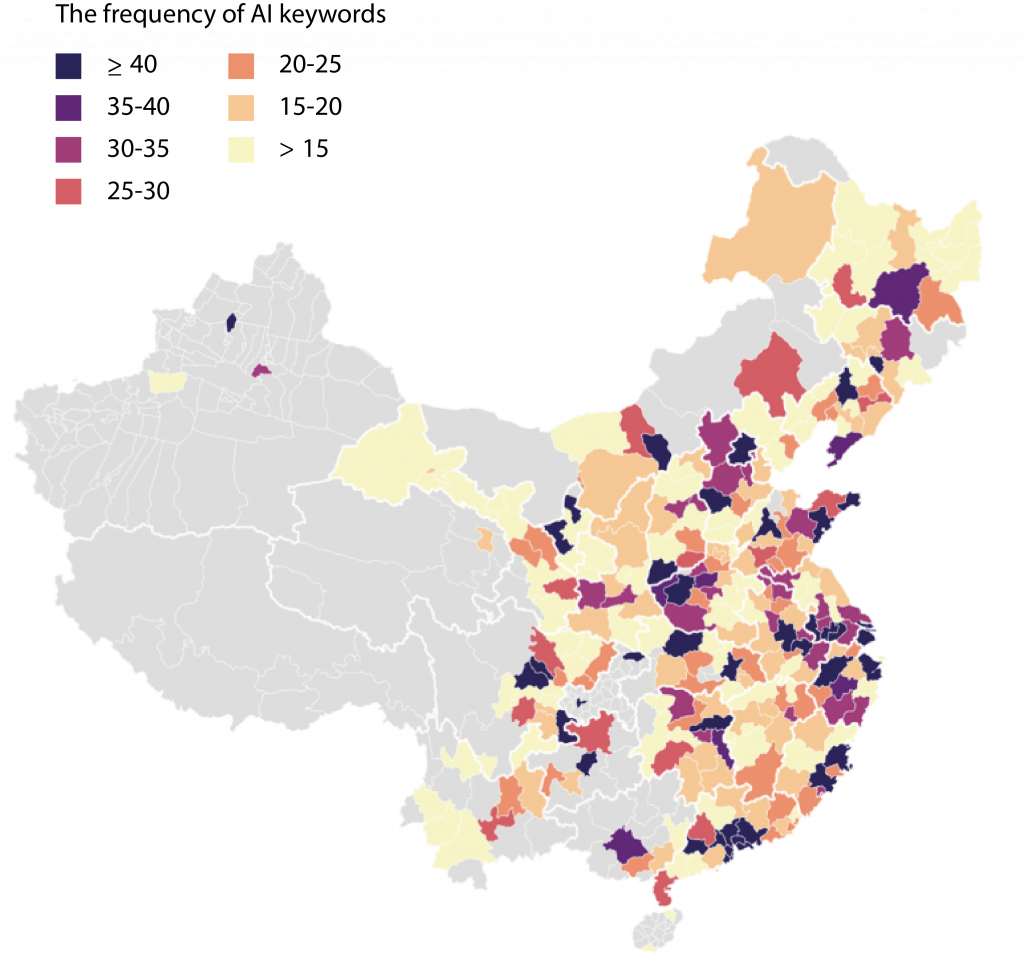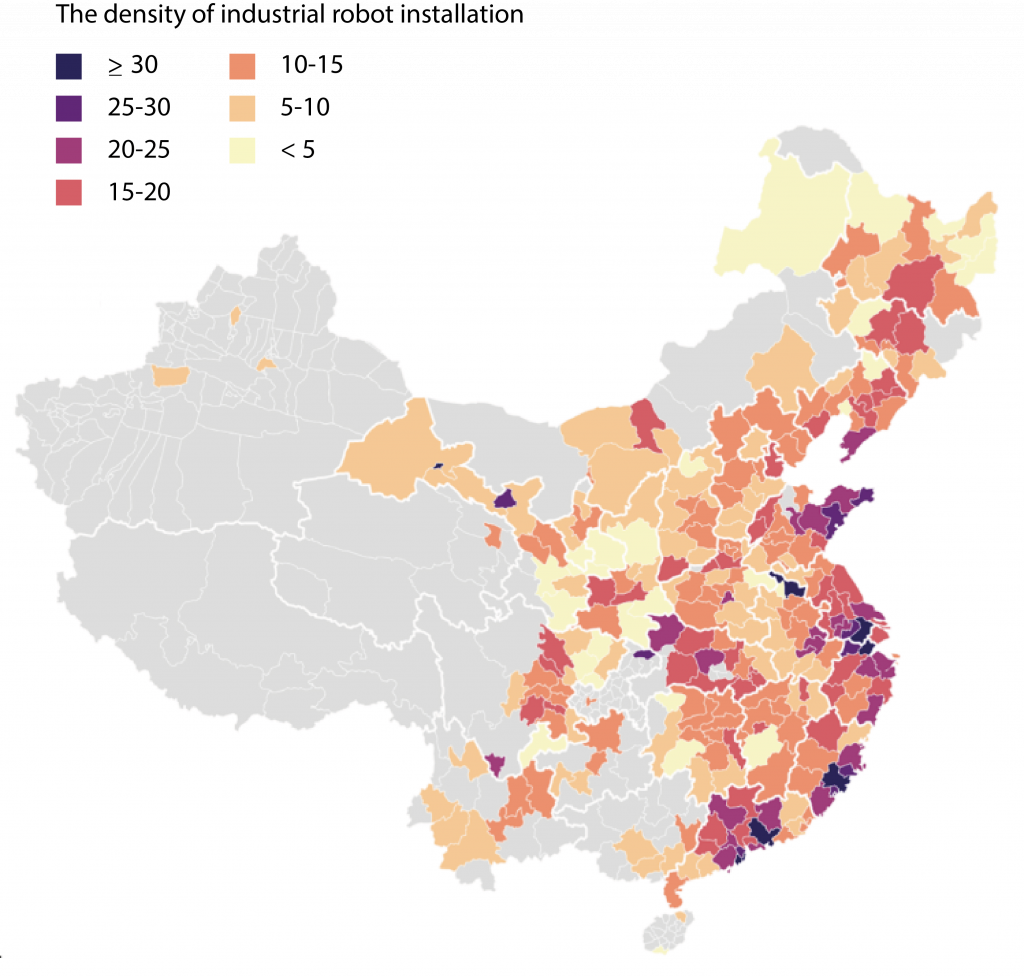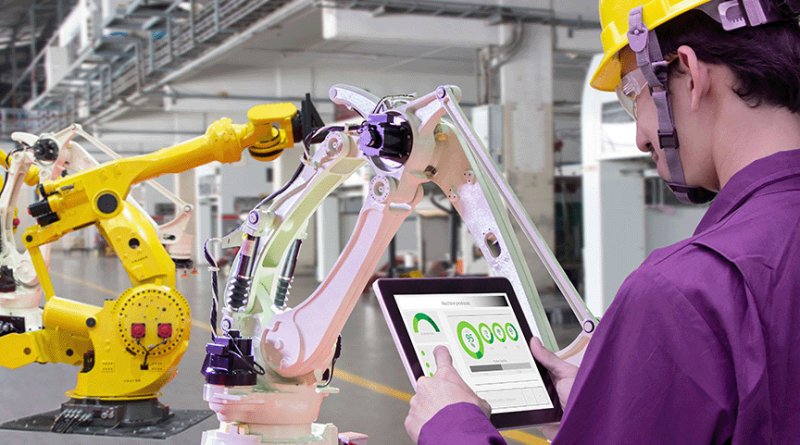Bridging the innovation gap
Andrés Rodríguez-Pose is a Professor of Economic Geography at the London School of Economics, and Zhuoying You is a Research Fellow at Bocconi University and a PhD student at Ku Leuven
In recent years, the potential of artificial intelligence and robotics to revolutionise production processes and stimulate innovation has attracted considerable attention (eg. Presidente and Calì 2022). Despite this, their capacity to address disparities in innovation remains underexplored.
In our recent paper (Rodríguez-Pose and You 2024) we delve into the capacity of AI and robotics to not only spearhead technological innovation, but also to trigger innovation in the less developed and less innovative Chinese cities – those places where traditional innovation-boosting policies have often failed.
The geographical concentration of innovation
Science and technology (S&T) spending has traditionally been at the heart of innovation policies (Audretsch and Feldman 1996, Pavitt 1982). However, policies based on S&T have mostly favoured regions already at the forefront of technological progress and largely failed in less innovative areas, contributing to a massively uneven distribution of innovation.
Innovation has therefore become increasingly geographically concentrated in a few hubs endowed with substantial human and financial resources (Loumeau and Egger 2019). This concentration results in large disparities in innovation between more and less developed regions (Audretsch and Feldman 1996).
Less developed cities and regions, often positioned at or below the technological frontier, struggle to match the innovation outputs of their more advanced counterparts due to inadequate human capital and financial resources (Aghion et al 2019).
Policies aimed at promoting innovation, such as investments in S&T, have therefore contributed to a distribution of innovation across the world that is more geographically concentrated and uneven than that of virtually all other economic indicators, such as employment, income, investment, or productivity.
The potential of AI and robotics in China
AI and robotics – characterised by the implementation of technologies that enable machines to learn and make decisions without human intervention and by the use of programmable machines to perform tasks (Liu et al 2020), respectively – offer new avenues for stimulating innovation. It has been argued that investing in these technologies can significantly enhance productivity, economic growth, and innovation (eg. Acemoglu and Restrepo 2020). But are they also capable of bridging the innovation gap?
China, a country determined to become a global AI leader by 2025 (Ciocca and Biancotti 2018), is actively resorting to AI and robotics as a means to spur economic activity. It pioneered a national campaign to attract AI talent (Zeng 2021) that strengthened its position in the field.
Until 2017, Europe had more than twice the number of AI researchers compared to China. However, from 2015 to 2020, China’s AI skill penetration became 1.4 times the global average, trailing only behind India and the US (Lundvall and Rikap 2022). The campaign also aimed to promote AI for innovation in less innovative areas of the country.
Despite significant investments in science and technology, China’s technological innovation was (and remains) highly concentrated around the big Eastern hubs of Shanghai, Guangzhou, and Beijing (Li 2009). A shift in focus to AI and robotics was considered a way to address this polarisation in innovation.
The approach to promoting AI adopted in China has been decentralised. Local governments have been allowed to tailor AI development strategies to local conditions (Zeng 2021). Individual cities and regions have developed their own AI strategies, leading to a geography of AI that is more variegated than that of innovation.
AI is concentrated in traditional innovation hubs, such as the Pearl River Delta and the Yangtze River Delta, but its use has also become widespread in many inland provinces (Figure 1).
Less developed cities and regions, often positioned at or below the technological frontier, struggle to match the innovation outputs of their more advanced counterparts due to inadequate human capital and financial resources
Similarly, the adoption of industrial robots has grown significantly, particularly in the manufacturing sector. Since 2013, there has been a consistent increase in industrial robots.
Once again, the geography of robotics in China expands beyond the traditional industrial hubs, with robotics making substantial inroads in provinces such as Henan, Shandong, Fujian, Hebei, and Anhui, outside the main Chinese innovation centres (Figure 2).
Figure 1. AI development in mainland China, 2008-2018

Figure 2. Geographical distribution of the average density of industrial robots in mainland China, 2008-2018

AI and robotics and the innovation gap in China
Has this drive to promote AI and robotics delivered? And has it contributed to reduce the acute geographical innovation gap in China? We argue that, in the case of China, AI and robotics have acted as catalysts for technological innovation across cities and regions, particularly enhancing innovation in traditionally less innovative places.
After examining the impact of investment in AI and robotics on technological innovation across 270 Chinese cities from 2009 to 2019, we posit that these novel technologies not only have driven innovation directly but have also enhanced the returns on S&T investments. This dual effect is particularly pronounced in regions at or below the technological frontier, thus offering a promising strategy for reducing regional innovation disparities.
We show that investments in AI in Chinese cities correlate with an increase in innovation overall. Similarly, the density of industrial robots is positively associated with technological innovation, suggesting that cities with more robot installations tend to have higher patent intensities.
Furthermore, we also find that the impact of AI and robotics varies across the innovation spectrum. While these technologies enhance innovation in all cities, their effects tend to be more substantial in traditionally less innovative regions. This finding suggests that AI and robotics can help bridge the innovation gap by providing greater relative benefits to cities below the technological frontier.
Our study also highlights the moderating roles of AI and robotics on the relationship between S&T expenditure and technological innovation. AI and robotics amplify the positive effects of S&T investments on innovation. This moderating effect is particularly strong in less innovative cities, further underscoring the potential of these technologies to reduce regional innovation disparities.
Policy implications
The results of our study point to the need to include AI and robotics as integral components of innovation strategies aimed at fostering technological progress across all regions. Subnational governments, particularly in less developed areas, need to prioritise the development and adoption of these technologies as a more effective way than old-style innovation strategies to enhance innovation across the board.
The findings underscore the limitations of traditional S&T investments in driving innovation in less developed regions. While S&T expenditure remains important as a tool to promote innovation, its returns are greatly enhanced by initiatives that promote the deployment of AI and robotics.
This integrated approach can boost the returns on S&T investments and ensure that the benefits of technological progress are more inclusive and more evenly distributed across people and territories.
By focusing on AI and robotics, governments can develop targeted strategies that not only increase overall innovation but also specifically support less innovative cities. This targeted support can help mitigate the risks associated with regional disparities in innovation, such as economic stagnation, social inequality, and political discontent.
Overall, AI and robotics have demonstrated themselves in China to be powerful drivers of technological innovation and effective mechanisms for reducing regional disparities in innovation performance. Integrating these technologies into innovation strategies can foster more inclusive and sustainable economic growth, ensuring, as Baldwin (2019) has stressed, that changes towards AI and robotics “will give more ‘head’ to people with big hearts, but no extra heart to people with big heads.”
Hence, innovation based on AI and robotics will encourage the use of new types of skills that are more widely distributed across all territories, meaning that the benefits of technological progress, as shown in the case of China, are shared more widely, ultimately leading to greater economic and social wellbeing.
References
Acemoglu, D and P Restrepo (2020), “Robots and jobs: Evidence from US labor markets”, Journal of Political Economy 128(6): 2188-2244.
Aghion, P, BF Jones and CI Jones (2019), “Artificial Intelligence and Economic Growth”, in The Economics of Artificial Intelligence: An Agenda, NBER.
Audretsch, DB and MP Feldman (1996), “R&D spillovers and the geography of innovation and production”, The American Economic Review 86(3): 630-640.
Baldwin, R (2019), “Globalisation, automation and the history of work: Looking back to understand the future”, VoxEU.org, 31 January.
Ciocca, P and C Biancotti (2018), “The economic geography of innovation”, VoxEU.org, 23 October.
Liu J, H Chang, JYL Forrest and B Yang (2020), “Influence of artificial intelligence on technological innovation: Evidence from the panel data of China’s manufacturing sectors”, Technological Forecasting and Social Change 158: 120142.
Loumeau, N and P Egger (2019), “Data superpowers in the age of AI: A research agenda”, VoxEU.org, 16 January.
Lundvall, BÅ and C Rikap (2022), “China’s catching-up in artificial intelligence seen as a co-evolution of corporate and national innovation systems”, Research Policy 51(1).
Pavitt, K (1982), “R&D, patenting and innovative activities A statistical exploration”, Research Policy 11: 33–51.
Presidente, G and M Calì 2022, “Robots for economic development”, VoxEU.org, 13 March.
Rodríguez-Pose, A and Z You (2024), “Bridging the Innovation Gap. AI and Robotics as Drivers of China’s Urban Innovation”, CEPR Discussion Paper DP19010.
Zeng, J (2021), “China’s Artificial Intelligence Innovation: A Top-Down National Command Approach?” Global Policy 12(3): 399–409.
This article was originally published on VoxEU.org.




